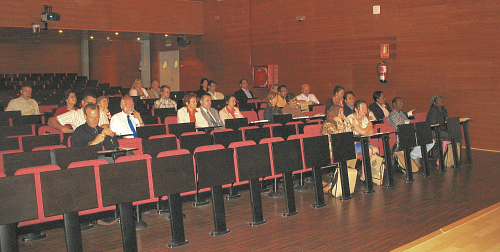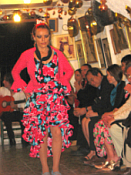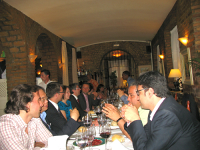Second International Conference on Environmental Toxicology
![]() 4 - 6 June 2008
4 - 6 June 2008
Granada, Spain
Overview
 The 2nd International Conference on Environmental Toxicology recently took place at the University of Granada, organised by that Institution and the Wessex Institute of Technology of the UK; with the collaboration of the University of Thessaly in Greece.
The 2nd International Conference on Environmental Toxicology recently took place at the University of Granada, organised by that Institution and the Wessex Institute of Technology of the UK; with the collaboration of the University of Thessaly in Greece.
The meeting addresses the need for the exchange of scientific information among experts or issues related to environmental toxicology, toxicity assessment and hazardous waste management.
It has become essential to assess the effects on the ecosystem of the thousands of new chemicals entering the market each year. The issue is complex since it depends on the organisms tested and it involves not only toxicity of single chemicals, but also interactive effects, as well as geotoxicity, mutagenecity, immunotoxicity and testing.
The Conference brought together researchers, managers, policy makers and other groups of the scientific community who are active in the related areas and to provide them with a forum for the exchange of information.
The meeting was opened by Professor Dorothy Nelly, Vice Rector for International Relations, University of Granada, who spoke of the commitment of her institution to strengthening research links with many institutions around the world. She was impressed by the number of different countries represented, which is characteristic of most Wessex Institute of Technology conferences.
Professor Montserrat Zamorano, Co-Chairman of the Meeting, spoke about the conference’s field of interest and welcomed the delegates to Granada, a city that offers a number of attractions in addition to the famous Alhambra Palace.
Professor Carlos A. Brebbia, Director of Wessex Institute of Technology and Co-Chairman of the Meeting explained the aims of the Institute and the way in which its activities are structured, with particular reference to the research carried out on environmental and ecological topics. The Institute has formal links with many organisations around the world, including one with the University of Granada, which he hopes will grow further in the future. This Conference, as well as the previous meeting on Water Management, are a reflection of this collaboration. Carlos said that conferences such as this one are important to foster the aims of WIT, which can be summarised as promoting knowledge transfer at international level.
Carlos concluded by showing some of the new accommodation and conference facilities on WIT’s Campus in the New Forest. He hopes that some of the participants will consider visiting the Institute next time they are in the region.

Conference Sessions
 The conference sessions were headed:
The conference sessions were headed:
- Human health risk
- Effluent toxicity
- Risk assessment
- Bioaccumulation of chemicals
- Biological effects monitoring
- Biodegradation and bioremediation
- Laboratory testing and validation
- Ecotoxicity and emerging chemicals
- New trends in environmental toxicology
Topics
The Conference programme included a series of invited presentations, ie:
- “Quantitative characterization of response behaviours and individual variation in Chironomus riparius after the treatments of diazinon” by TS Chon, Pusan National University, South Korea
- “Developing corporate environment and health strategy: review of existing corporate citizenship (CC) models” by K Duncan, University of Toronto, Canada
- “Toxicity assessment of effluents” by T Tisler, National Institute of Chemistry, Slovenia
- “Study of phytotoxic properties of sewage sludge stabilised by alkaline mediums” by C A Papadimitriou, Technical Educational Institute of West Macedonia, Greece
- “When can surfactants enhance hydrocarbon biodegradation in oil biotreatments?” by C Calvo-Sainz, University of Granada, Spain
- “Surface water toxicity assessment by ecotoxicological and in vitro toxicological assays” by C Khalil, University of New South Australia, Australia
- “Application of bioassays and soil column test for toxicity evaluation of selected pesticides” by A Kungolos, University of Thessaly, Greece
Conference Dinner
The Conference dinner took place in a restaurant renowned for its local specialities and fresh produce from its own farm. The delegates had occasion to taste different dishes before visiting one of the famous gypsy shows of Granada. The cave where it took place was part of a group that has belonged to the same family for generations and the show was exceptional. Granada flamenco is unique in that it is more faithful to its traditions than other kinds, and is performed in the caves where the gypsies lived.


International Scientific Advisory Committee
The members of the International Scientific Advisory committee met to discuss the Conference and discuss ways of improving it. They were unanimous in thinking that the meeting has been a great success and that the papers and discussions were of a high quality. The ISAC thinks that it should be reconvened in 2010 and the location will be decided shortly. The updated call for papers will contain a series of new topics and several colleagues will be invited to join the Committee.
Abstract and Paper Submission
The proceedings of Environmental Toxicology II, 368pp (ISBN: 1-84564-114-6) are available in hard back from WIT Press priced at £121/US$242/€181.50. Orders can be placed by telephone: +44 (0) 238 029 3223, fax: +44 (0) 238 029 2853, e-mail:
Papers from the conference will also be hosted online at the WIT eLibrary as volume 110 of WIT Transactions on Ecology and the Environment (ISSN: 1743-3541). For more details visit the WIT eLibrary at: library.witpress.com


 Wessex Institute
Wessex Institute